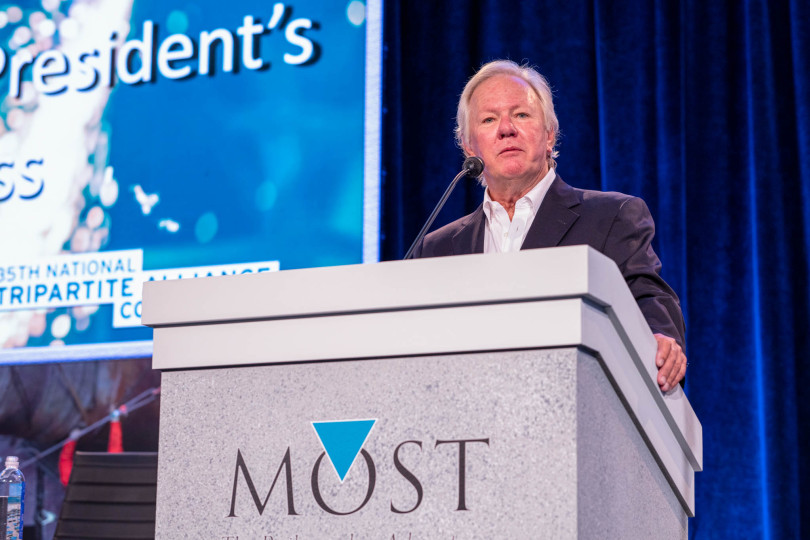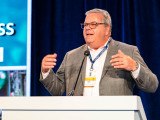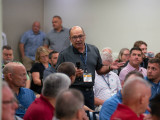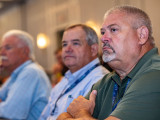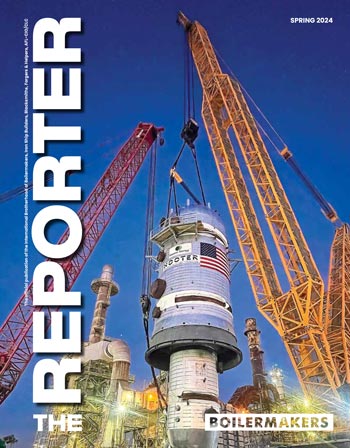We have to evolve to keep our craft alive and ready for what’s coming.
IP Newton Jones stresses the importance of building a ready Boilermaker workforce.
View Photo Gallery (7 photos)
Back after a three-year hiatus due to the pandemic, the 35th MOST National Tripartite Alliance conference opened Aug. 23 in Destin, Florida, with a focus on increased work on the horizon and new initiatives and strategies to boost work opportunities for Boilermakers, contractors and owners.
“We have to keep our shoulder to the wheel with the M.O.R.E. Work Investment Fund, and we have to evolve to keep our craft alive and ready for what’s coming,” said Conference Chairman and Boilermakers International President Newton B. Jones in his opening remarks.
Strategies within the M.O.R.E. Work Investment Fund are setting the foundation for Boilermakers, contractors and owners to take advantage of new work projected to come online as a result of the Infrastructure Investment and Jobs Act, Inflation Reduction Act, transitioning energy landscape and other factors, he said.
IP Jones reminded attendees about the success of the precursor to the formal M.O.R.E. Work program, in which the Western States Section initially invested less than $1 million in the California state legislation (SB 54) campaign. That campaign resulted in 3 million additional man-hours for Boilermakers with millions more in man-hours for other crafts.
“That was an over 1,000% return on investment,” he said. “And we signed on 31 new contractors and brought in at least 1,800 new members in two California locals.”
Now formally and fully running since 2019, the M.O.R.E. Work program has expanded. In addition to the four core focus areas (marketing, organizing, recruitment and employment), work recovery and job targeting initiatives are investing in tactics to reclaim lost work, gain work in new industries and allow contractors to generate more competitive bids.
“All of these strategies are tools for surviving this unprecedented transformation. It’s going to be ongoing and a long process,” said IP Jones.
He pointed to developments in recruiting strategies, including the launch of a new centralized online application system and boot camp style training. He called attention to a new boot camp training program being built out at the U.S. Army’s Fort Benning, Georgia, base where the army is providing a building for the Boilermakers’ training, aimed at soldiers who are preparing to leave the service.
IP Jones also called attention to the Boilermaker Women at Work program, focused on recruiting and retaining female members and fostering leadership development paths for female Boilermakers.
“The Women at Work initiative is a very important strategy, because there are a lot of women who want to go to work and can do this work,” he said. “And who do you think built the Liberty ships during World War II?”
Another strategy, Climate Change Solution Initiatives, was a major topic of the conference and was identified by several key presenters as critical to a healthy future for Boilermakers, contractors and owners.
Spencer Schecht, Senior Client Engagement Lead for the Global CCS Institute, outlined several points in the Infrastructure Investment and Jobs Act and Inflation Reduction Act that will have a direct impact on accelerating carbon capture deployment in the United States. Of note, $12 billion has been earmarked for CCUS enhancements to the 45Q tax credit that make CCUS more attractive as an option.
“This creates a market with economic certainty,” Schecht said. “What this means is that [carbon capture technology] is going to be a big part of climate conversations going forward.”
He reported that in the U.S., Houston, Texas, and the Gulf Coast, the Northern Plains, Midwest, Appalachia and California are CCUS hotspots, and in Canada, Alberta and Saskatchewan are CCUS leaders. There are currently 18 commercial projects operating or in construction in North America, and 74-plus commercial projects in development.
Schecht said that to further enable carbon capture deployment, there needs to be incentivization through government, significant capital through investment and a policy framework put in place that gives investors confidence in the business case for positive return on investment.
Boilermakers International Director of Climate Change Policy Solutions Cory Channon said that Boilermakers’ message about CCUS and other solutions is finally taking root. He stressed the importance of collaborating, advocating for an “all of the above” energy and carbon dioxide mitigation strategy and combating misinformation from environmental extremists.
“The world is in our hands now,” he said. “We need to shift the mind of the people to shift the government. The villain is CO2.”
Two entrepreneurs and visionaries who presented at earlier Boilermakers’ conferences showcased their plans for carbon-negative hydrogen projects that utilize unique feedstock and incorporate carbon capture.
Ian MacGregor, founder of Hydrogen Naturally, Inc., laid out his plans for a project that will produce what he describes as “bright green hydrogen” at hydrogen “hubs” in Canada and the U.S. The hubs will use scrap wood fiber—that otherwise is left to rot—as feedstock. The hubs’ Natural Air Capture Facility will make and sequester CO2 and will manufacture renewable fuels.
“What we’re focusing on is the full carbon cycle, and we will be negative in the hydrogen we make,” MacGregor said. “We’re not zero, we’re less than zero, because the tree took the carbon out of the air.”
The hubs will be built in identical train processes akin to an assembly line process so they can be continuously built. MacGregor estimates thousands of jobs will result from building and maintaining the hubs, as well as the forestry aspect required.
Dr. Evan Blumer’s proposed project, which uses a unique pressurized, fluidized bed combustion system, is a finalist in the U.S. Department of Energy’s 21st Century Power Plant Program—a competitive search for the “power plant of the future.” He plans to burn coal waste and co-fire with biomass from Pennsylvania forests, spurring critical forest management. (Read more at “Northeast Area Tripartite looks to the future” on page XX.)
Brad Crabtree, Assistant Secretary for the U.S. Department of Energy’s Office of Fossil Energy and Carbon Management, made a special appearance via Zoom to address the conference on the urgency of meeting climate goals and deploying projects relative to funding in the Infrastructure Investment and Jobs Act and Inflation Reduction Act.
“We have a big gap to close in just under a decade, and the Boilermakers in Canada and the U.S. have helped lead the charge among unions to ensure that we meet this challenge,” he said.
Crabtree lauded the magnitude of the Infrastructure Investment and Jobs Act which provides $62 billion over five years to the DOE for “all things involving energy and climate,” $12 billion-plus of which is for carbon management technology and infrastructure. He said this represents the world’s largest investment to date by a government for carbon management.
“It’s an historic accomplishment—not just in the amount of money, but because the law extends beyond traditional research and development,” he said. “We now have the tools and resources to invest in real world technology that brings innovation to the marketplace.”
He noted the law is a “once in generation opportunity” and that the department is working overtime to implement the provisions.
Said IP Jones: “[The Infrastructure Investment and Jobs Act and Inflation Reduction Act] will bring us—all of us—a whole lot of work. We’re seeing the focus shift to carbon capture, use and storage; hydrogen and nuclear—and manpower for new projects is going to be an issue for all crafts. We have to work to recruit and train people.”
In addition to the Boilermakers’ M.O.R.E. Work program strategies and tactics, IP Jones announced that discussions had begun with the Ironworkers union to create an alliance that would ensure the glut of near and longer-term jobs opportune to both unions could be adequately manned.
“We want to get to a solution and put Ironworkers and Boilermakers to work and make sure the contractors and owners have the skilled workforce they need,” said Ironworkers President Eric Dean.
Both Dean and IP Jones emphasized that discussions about a strategic alliance are still in early stages.
“We might fight sometimes, but like brothers, when we put our backs together, everyone else stands a losing chance,” Dean said. “When we have each other’s backs, we’re unstoppable.”
As with past MOST NTA conferences, Boilermakers, contractors and owners met separately in caucuses and then reported out to the conference to address issues together. Top concerns among all three groups were: maintaining safety on the job and, in light of the recent legislation and funding, recruiting, retaining and training skilled manpower.
“There’s a whole lot of work on the horizon,” IP Jones said. “There’s a whole lot of money being invested by our government on things that are good for building trades and workers. We all need to understand: We need to build our workforce back.”

